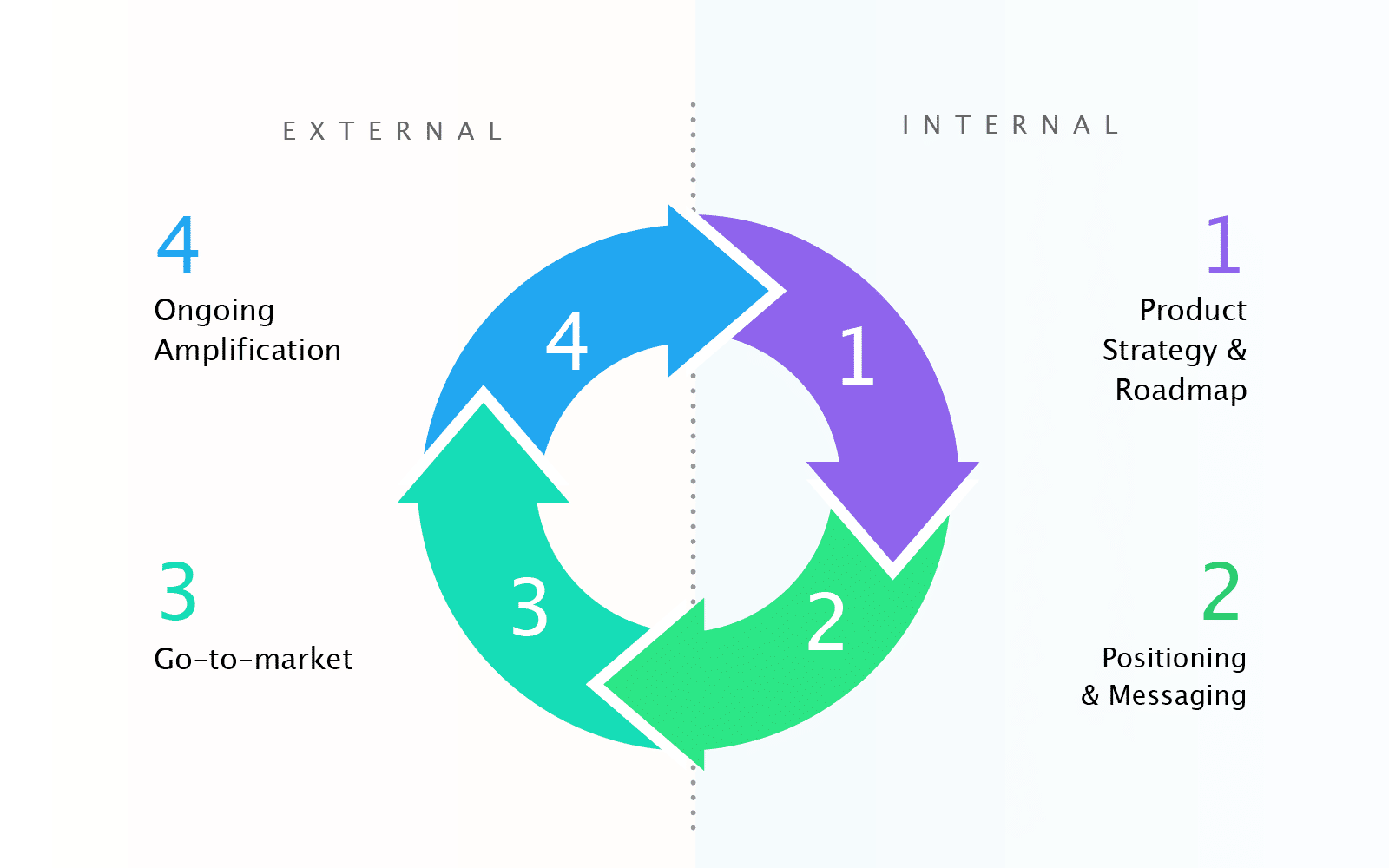One of the most recent and significant developments in software marketing nowadays is the evolution of product marketing, therefore, it’s vital to understand it and know how to apply it to your work or organization. Continue reading for a strategic and tactical explanation of “What is Product Marketing?” Since everyone employs product marketing managers (PMMs), there is a big demand for knowledge in this field. Here is a complete list of everything we currently have in stock: product marketing examples, strategies, marketing managers, and their salaries
Product Marketing
The link between the market and the product in both directions is product marketing. Therefore, the product marketing function is in charge of developing the product, positioning it as a solution, and understanding the demands and needs of the market.
During the course of a typical day, a product marketer may write positioning and messaging, introduce new features and products, interact with consumers, or assist other teams in closing deals. We are situated at the nexus of product strategy, sales, customer success, and marketing for this reason. This demonstrates the enormous influence product marketing can have, but it also makes it more difficult to provide a general picture of what we do.
A product marketer may just focus on product positioning in some businesses. In other cases, the goal is to increase sales or the demand for the product. And they carry out each of those tasks in some businesses. Therefore, your next inquiry is undoubtedly..
What Is Product Marketing Actually Responsible For?
In product marketing, The primary duty of a product marketer is to speak for the consumer. Product marketers are aware that consumers purchase solutions rather than products or features in order to address their issues. As a result, we’re focused on developing stories that incorporate consumer insights so that customers will perceive our goods as a method to address their issues and achieve their objectives. And this is a task that lasts long after the product has been released. It starts at the very beginning of product development.
The following are the main duties of a product marketer:
- Messaging and positioning
- Having complete control over the marketing strategy (like naming, packaging and pricing, partner activation, positioning, enablement, top-of-the-funnel and middle-of-the-funnel content, campaigns, and offers
- Assisting the sales team to close more transactions and earn more money
- Knowing the market, our clients, the driving forces behind our triumphs and failures, and the whole spectrum of the competition
- Making a product strategy decision and promoting new products (product launch)
- Increasing awareness, demand, acceptability, acceptance rates, and deal size
Note: It takes all of this work to develop an effective product marketing plan.
Product Marketing Examples
We made an effort to learn how it had previously been done. In order to build an audience, we created a list of eight companies examples that have mastered product marketing. They are as thus:
- Billie
- Grow and Convert
- MailChimp
- Unsplash
- Airbnb
- Tesla
- Nike
- Apple
#1. Billie
One of the good examples of product marketing is the Billie product. Women’s razor manufacturer Billie just debuted its #ProjectBodyHair campaign. It all began with a creative TV ad campaign that used body hair in advertisements for women’s razors. Their product team developed the idea for this campaign after performing market research to identify their competitive edge, which is the absence of body hair in women’s razor commercials. You can create a successful product marketing campaign by fusing this competitive advantage with the target audience’s pain points related to women’s inaccurate media representation.
Additionally, with over 21 million organic views, over 1.3 million shares, and comments on social media, this campaign alone generated over 3.3 billion earned media impressions across 23 countries.
#2. Grow and Convert
We made it clear that products don’t always have to be tangible objects in our guide on product marketing. They could be software or products, like the content marketing firm Grow and Convert. The Grow and Convert team made the decision to change the positioning of their business. They aimed to establish themselves as a prestigious, opulent, and high-end service. They need to position themselves so that they can attract clients who will spend a lot of money.
In order to find a market gap, Grow and Convert’s positioning approach in examples of product marketing involves a competitive analysis. Three gaps were discovered:
- A content marketing firm that prioritizes leads
- Inadequate promotion of the content
- Very few companies are able to provide top-notch B2B content.
- The company then changed its service and product offerings to capitalize.
#3. MailChimp
Initially, only an email marketing tool, MailChimp is now an “all-in-one marketing suite.” They don’t, however, solely promote themselves as a free marketing tool. Their product marketing team opted to concentrate most of their product marketing efforts on the items’ capacity to aid small firms in expanding after observing that their customers use their tool to achieve so.
On their landing page for “growing businesses,” they provide the following idea:
- The design studio and in-depth analytics that their product offers may be highlighted, for sure.
- On the other hand, MailChimp listened to customer feedback and created marketing that emphasizes how customers may use such skills.
#4. Unsplash
A website where people can share photos is called Unsplash. The videos of the photographers are available for visitors to download without charge. Unsplash has nailed their placement, despite the fact that it initially seems unimportant. They employ 158,881 photographers, which has led to a photo archive of almost 1.2 million images.
However, let me tell you how Unsplash promotes its free service. At the start, there was a book. To show support for their photographers, the Unsplash team decided to create a book containing all 30,000 of the images that were previously viewable on their website. Their Kickstarter campaign’s objective was to raise $75,000 there. To do this, they produced a little clip that summarized the subject of the book.
Unsplash’s understanding of its target audience was highlighted by the positioning lesson in the movie. Just from the video, they were able to raise almost $100,000, $25,000 more than they had anticipated.
#5. Airbnb
Without a doubt, Airbnb revolutionized the hospitality sector. They gave clients a method to find affordable housing, first in the form of an available room, saving them money on pricey hotels. Their brand positioning was perfect from the beginning. However, Airbnb recently changed the way it looked and added the “Bélo” sign. The same sense of belonging they first sought to provide their clients remains at the center of everything. You can rent a room, a posh apartment, or couch surf if you want to feel like you belong. According to Airbnb, the Belo stands for the following:
- It acts as a reflection of our windows, doors, and typical daily life on a global scale.
- Airbnb has an advantage once more despite only being based on its branding because of this sense of community. In a conventional hotel, visitors are not made to feel “at home.” But if they rent an Airbnb, they can discover a special place to explore and feel at home.
#6. Tesla
Tesla is not your typical playing card manufacturer. The eco-friendliness that underpins their entire brand statement has helped them establish a reputation:
- Along with producing electric cars, Tesla also develops renewable energy generating and storage solutions that are infinitely scalable. Tesla believes that the world should stop using fossil fuels as soon as feasible and transition to an emission-free future.
- This brand promise allowed Tesla to successfully target their consumers. They probably wouldn’t have gained such a huge market share if they had chosen the conventional car route. Market competition and specialization are too intense for Tesla’s products to stand apart.
- Instead, Tesla rules the high-end electric vehicle industry. Given how expensive they are, alternative electric vehicles are a mere drop in the bucket.
- As a result, they control nearly 80% of the American market for electric vehicles. The most popular electric vehicle is the Model 3.
#7. Coca-Cola
Coca-Cola, the company that makes soda, started out as a drugstore. It was advertised as a medicine to treat weariness and headaches. But in the late 1800s, because of a tax problem, they shifted their attention to the market for soft drinks. Their complete product marketing approach depends on this change in the target market. They have improved their positioning since then. Along with their products, the 7 Ps of product promotion hasn’t changed in decades.
What took place? Nowadays, practically all consumers who order cola almost always choose “Coke.” Pepsi, its main rival, borrowed the concept and released a TV commercial earlier this year due to its strong brand associations. Because of this strong link, Coca-Cola products may be known to more than 95% of people worldwide.
#8. Apple
How is it possible that Apple is one of the best instances of effective product marketing? People spend hours doing research on new products before they are published. For the new iPhone, there are lines of customers, and the news is widely reported. Why? They employ a product marketing strategy that annoys customers and encourages brand loyalty.
Apple’s product marketing approach goes beyond merely presenting its goods. They boost brand recognition, which product marketers can use to inform their launch plans.
What took place? The brand language used by Uber is specifically aimed at us and describes its features in terms we can readily comprehend.
Read Also: HOW TO WRITE AN EFFECTIVE PRODUCT DESCRIPTION: Detailed Guide
Product Marketing Strategy
The development and marketing of your product will be guided by a product marketing strategy. You can pick how to market and promote your product using this strategy, both before and after launch.
Every product marketing strategy must comprise the eight steps listed below.
#1. Customer Development
Before discussing your items, you must define your target market. In essence, prior to creating client personas, a product marketer must define their target market. As a result, you will be better able to comprehend the traits, requirements, and interests of the buyer. Using this data, you may create a message that resonates with your intended audience.
#2 Positioning & Messaging.
Determine who you are speaking to before deciding what to say. Utilizing the knowledge you have collected about your target market, develop a narrative that positions your product as a solution to their concerns.
Don’t forget to highlight the unique qualities of your products, as doing so will help you stand out from competitors.
Everything ultimately boils down to these five questions:
- For whom is this product intended?
- What is the result of this?
- Why would buyers specifically want to use it?
- Why are users presently required to have it?
- What sets this product apart from what is already on the market?
Your positioning and messaging are successful if your target audience can resolve these problems with ease.
#3. Sharing Positioning & Messaging
Your company’s positioning and messaging will only be effective if every employee is on the same page. Think about how confused your clients would be if you tried to communicate multiple ideas at once. Product marketers must therefore gain the support of all organizational levels, educate everyone on the key messages, and lead projects that will increase sales and customer satisfaction. By doing this, you can make sure that your messaging is correct and consistent.
For the positioning of your brand as a whole, sharing your positioning and messaging is also crucial. If you are successful in achieving this, you will be equipped to work with the other marketing team members to convey a potent GTM message. Your wider brand strategy depends on this kind of activity, in which product marketers work together with other members of the marketing team to provide a powerful GTM message.
#4 Putting Together a Launch Plan
What is the best way to prepare your team for a launch that will be successful? Create a launch plan.
A product launch typically involves teams from multiple internal departments, such as marketing, sales, and support. Product marketers need to be in charge of the launch plan in order to manage these shifting components.
When creating your launch strategy, work backward. Establish a clear goal and launch date after identifying what needs to be done to ensure a successful and timely launch. A successful launch depends on an effective launch plan because, in the end, demand and win rate are what most product marketers are judged on.
#5. Creating Launch Content
Your launch material is the keystone of your launch plan. This includes all of the launch-related resources you’ll need, such as blog posts, one-pagers, demos, positioning papers, product screenshots, pitch decks, one-pagers, demos, positioning documents, and landing pages.
As you work with other teams to create this information, take tracking into consideration. The only way to determine how successful your launch was is to monitor your material.
#6. Preparing the Team
While informing your clients about this fantastic new product or service, don’t forget to inform your team as well. For the debut of a new product, internal communication is equally as important as external communication. Make sure your entire team, including those in sales, customer success, marketing, and product, is organized and ready before launching a website or getting your support team ready to answer calls and handle chats.
#7. Product Launch
As clients begin to really arrive, a product marketer’s strategy changes at this time. Just be aware that things won’t always go as planned and be ready to make quick adjustments.
#8. Post-launch
You were prosperous! The time has arrived to consider it. Call a meeting to discuss the past and pinpoint areas that could use improvement. Don’t forget to celebrate all of your accomplishments, especially the one on launch day, while you have the chance.
Prior to choosing adoption KPIs with your product team after launch, be sure to carefully monitor both internal and external input for at least a quarter. This is yet another approach to evaluating how well your launch plan is working. To more accurately evaluate the launch’s success, add up-sell and cross-sell analytics to these figures.
Product Marketing Manager
The product marketing manager researches and assesses market trends, brand performance, brand competition, and product performance in order to design strategies for the chosen brand. manages, creates, and carries out marketing initiatives to increase the sales of a certain brand.
A product marketing manager’s duty is to ensure that brand and product actions enhance the company’s reputation. works in conjunction with sales teams to develop and implement effective sales strategies. The job of product marketing manager could also call for a bachelor’s degree. routinely makes management reports. The product marketing manager is in charge of overseeing the daily operations of less seasoned employees. A trustworthy first-level manager makes sure that stated budget limits are followed and that project/department milestones/goals are achieved. has complete control over decisions about hiring and firing. A usual requirement for employment as a product marketing manager is five years of individual contributor experience in the business. It might be necessary to have one to three years of supervisory experience. thorough understanding of the function and the department’s procedures.
Salary of Product Marketing Manager
The average annual salary for a product marketing manager in the US is $118,572, according to Glassdoor.
Typically, a product marketing manager makes $50.90 per hour. In the US, there are approximately 130,000 product marketing managers working. The actual may be substantially higher, though, given that numerous businesses frequently employ multiple titles for the same post.
Each product marketing manager’s remuneration and salary are mostly determined by their experience in product management and product marketing. The final salary is influenced by early initiatives, credentials, and schooling. Therefore, there is no variation in pay between genders for product marketing managers.
The Product Marketing Manager’s Salary Slopes
The salary scale is wide since the typical product marketing manager may serve in a number of roles for various businesses.
Product marketing managers can expect to make between $74,000 and $140,000 per year. Based on their years of experience, product marketing managers are paid at the top of the scale. In many cases, they have connections in the business world in addition to graduate and undergraduate degrees from prestigious colleges.
In addition to their salaries, employees generally receive $9,487 in bonuses and benefits. It typically ranges from $2,504 to $29,120. The following shows the product marketing manager’s salary ranges by size.
- 0–50 Workers: Average base pay is $88,087, and annual salary is $60,000–$117,000.
- 51-200 employees earn $96,536 on average, ranging from $67,000 to $128,000.
- 201–500 employees earn $99,211 on average, with a range of $69,000–132,000.
- The 501–1000 group earns an average of $101,773, ranging from $71,000 to $135,000.
- The median group, 1001–5000 employees, has a base salary range of $73,000–139,000 and an average increase of $104,719.
- On average, 5001+ employee companies earn $78,000 to $146,000. Significant change.
The following shows product marketing managers’ average salaries and benefits by experience.
- New workers start at $80,172 and make $55,000–$107,000. Beginner
- 1–3 Years: This person may have sales facilitation experience (for example, as a sales representative). Their average salary is $87,098.
- With 4-6 years of expertise, you can expect $102,026, which is the industry standard. Annual salary are $71,000–$135,000.
- 7–9 Years of Experience: Average salary is $112,167, with a range of $79,000–$148,000.
- 10-14 Years of Experience: You may expect a terrific average salary of $122,574 with a typical salary range of $86,000-161,000.
- Product marketing managers often become vice presidents after 15 years. They average $129,000 a year.
What do you mean by “product marketing”?
Product marketing is putting a product on the market and monitoring its success overall by seeing how much demand and usage it receives.
What is the role of product marketing?
- increase brand recognition
- increase a business’s market share.
- Launch novel goods and services, or stray from current paradigms.
What Are Some Examples of Product Marketing?
- Using email to announce a new feature is clever.
- Nolt: Non-interactive product demonstration for attracting customers
- Notion: Quick sign-up that swiftly results in an aha moment
- Intercom: promoting the existing product through conversational marketing
The 4 Types of Marketing?
- Email Marketing
- Influencer Marketing
- Database marketing
- Social Media Marketing
What Are Common Product Marketing Strategies?
- Identify the buyer personas and target market for your product.
- Establish your product’s positioning and messaging to differentiate it.
- Set objectives for your product.
- Set a price for your goods.
- Introduce your product.
Best Way to Promote a Product?
- Give devoted clients a unique sneak peek.
- Use a unique starting deal.
- Take advantage of Google My Business.
- Run a contest on social media.
- Use email to communicate with others.
- Create a blog entry.
- host a gathering.
- Offer an upgrade without cost.
What Is the Difference between Product Marketing and Marketing?
Product marketing focuses exclusively on the features and functions of the product, while marketing emphasizes the benefits for customers on a company level.






